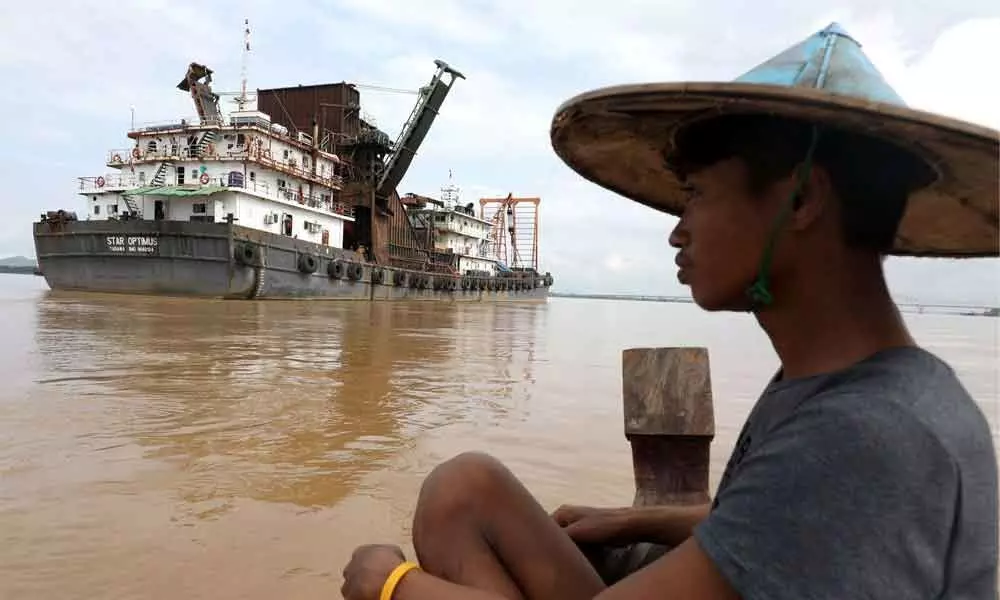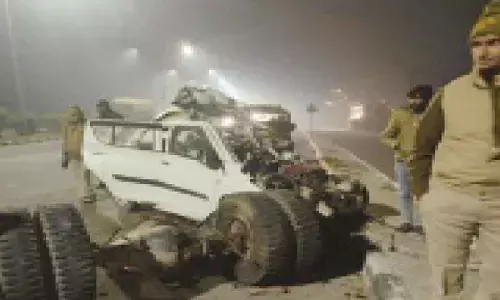Myanmar farmers lose their land, all thanks to sand mining

From a boat on the Salween River in south-eastern Myanmar, Than Zaw Oo pointed to a brown stretch of water he said was once full of lush paddy fields.
"This used to be my land," said the 51-year-old farmer, frowning at the murky waves.
All but six of the 24 acres where he used to grow rice and vegetables have slipped into the water in recent years, he said. Another farmer, Than Tun, said he had lost 15 acres of his land to erosion. While official records were not available, other villagers backed their accounts.
Farmers and politicians in Chaungzon township, just outside the southern town of Moulmein, worry that erosion in the area is being exacerbated by the ships that dredge its bed for sand each night. The sand is mainly bound for Singapore, the world's biggest importer, for use in reclamation and construction projects.
Both the Myanmar government and the company whose ships do the dredging in Chaungzon deny the dredging is causing the erosion. But the dispute highlights the fractious issue of sand-mining in Southeast Asia as Singapore is forced to look farther afield to slake its thirst for the mineral following bans on the trade in countries like Malaysia and Indonesia over environmental concerns.
Sand mining has been blamed by scientists for damaging sensitive ecosystems around the world, accelerating coastal and riverine erosion, and exacerbating the frequency and severity of floods and droughts, according to a 2019 report by the U.N Environment Programme.
Malaysia, formerly the biggest source of sand for Singapore, in 2018 introduced an outright ban on the export of sea sand, used for land reclamation, and imposed tighter controls on river sand, used mostly in construction.
Cambodia made a similar move in 2017, while Indonesia banned exports to Singapore in 2007, causing a "sand crisis" that brought building activity almost to a halt. Singapore, an island state that has grown 25 percent since its independence in 1965 thanks largely to aggressive land reclamation, has since bolstered its stockpiles, according to sand traders.
Officials in Myanmar and industry sources in Singapore say the bans have prompted Singapore to seek new supplies from countries like Myanmar.
Almost 1 million tonnes of sand went from Myanmar to Singapore in 2018, earning over $6 million, according to the most recent UN data on the trade. That amount is expected to have increased substantially following the Malaysia bans, according to the Myanmar government.
"Since the Philippines, Cambodia, and Vietnam almost completely stopped exporting sand to Singapore, the sand from Myanmar has become much more in demand," said Aye Lwin, joint secretary-general of the Myanmar Port Authority, which grants licenses for sand-mining operations.
The benefits of the mining – including tax revenues for the government – outweighed the costs, he said.
"I believe it only causes little environmental damage," Aye Lwin said. "But it generates funds for the government."
The Singapore-registered company dredging in Chaungzon, Starhigh Asia Pacific Pte Ltd., has extracted hundreds of thousands of tonnes of sand since 2013, according to the local member of Parliament, Kyi Kyi Mya. She said at least 150,000 tonnes were extracted in 2018-2019, but did not have the exact number for other years.
Starhigh dredges the sand legally through a licence with the local government that does not limit the amount of sand the company can extract.
Most of the sand Starhigh extracts is sent to Singapore. The company last year bid to supply sand to JTC Corporation, a Singapore government agency for infrastructure development, according to a tender on a government procurement site.
Starhigh also supplied sand for a JTC reclamation project in Singapore completed in 2018, according to Starhigh's managing director, Si Thu Phyo. He said the sand for that project came from Myanmar as well as Vietnam and the Philippines.
JTC referred questions from Reuters to Singapore's Ministry of National Development, which said the country imports sand on a commercial basis and that suppliers are expected to abide by laws and regulations in source countries. The Myanmar government says the environmental impact of the dredging is minimal and necessary to clear waterways of built-up sediment.
In 2014, the company paid compensation to local farmers who claimed that mining too close to the shore had led to landslides, according to Kyi Kyi Mya, the MP in Chaungzon.
Starhigh did not comment on any compensation paid to farmers but said "whenever it is possible, we will help locals with small landfill work at our own cost."
Si Thu Phyo, the Starhigh managing director, told Reuters that erosion was present in the area before dredging work started.
"Dredging is always an easy target when it comes to environmental complaints," he said. "People don't understand and are worried."
Riverbank erosion along the Salween is not an entirely new phenomenon, with factors including climate change worsening the problem by contributing to higher levels of flooding and siltation, said Vanessa Lamb, a geography lecturer at the University of Melbourne who has studied the river.
She said that a lack of baseline data about the river made it difficult to track just how much sand dredging was affecting riverbank erosion. But in a 2019 research paper, Lamb said locals blamed accelerating erosion on the rise in sand-mining. It was not possible to verify those claims from local records or old photographs.
Dr Aung Naing Oo, deputy speaker of the Mon state parliament and the author of a parliamentary report on sand extraction in the region, said there was little transparency around the industry.
He said that there was no consistent monitoring process and that authorities were not checking how much sand was being extracted or whether companies were taking material only from agreed sites.
For now, the government says it does not have plans to end the dredging or compensate farmers for lost land.
Than Zaw Oo, the farmer in Chaungzon, said he is now in debt after borrowing more than $2,600 to pay for embankments in an attempt to keep erosion at bay.
"I am lost and I don't know what to do," he said. "The sadness is just beyond words."
Sand mining has been blamed by scientists for damaging sensitive ecosystems around the world, accelerating coastal and riverine erosion, and exacerbating the frequency and severity of floods and droughts, according to a 2019 report by the UN Environment Programme. Malaysia, formerly the biggest source of sand for Singapore, in 2018 introduced an outright ban on the export of sea sand, used for land reclamation, and imposed tighter controls on river sand, used mostly in construction. Cambodia made a similar move in 2017, while Indonesia banned exports to Singapore in 2007, causing a "sand crisis" that brought building activity almost to a halt. Singapore, an island state that has grown 25 percent since its independence in 1965 thanks largely to aggressive land reclamation, has since bolstered its stockpiles, according to sand traders.














